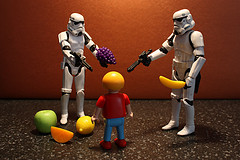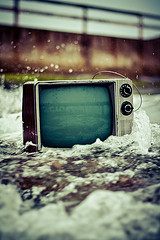 The TV is called the boob tube for a reason. While no scientific study has come right out and said television turns its viewers into so-called boobs, plenty of studies have examined the effects of TV violence on children and the results aren’t much better.
The TV is called the boob tube for a reason. While no scientific study has come right out and said television turns its viewers into so-called boobs, plenty of studies have examined the effects of TV violence on children and the results aren’t much better.
Major scientific studies have agreed the effects of TV violence generally falls into three main categories. It can create:
- Aggression and imitation
- Desensitization and a callous attitude
- Fear and a warped world view
Your anxious child’s exposure to TV violence doesn’t only come from action-packed, shoot-’em-up cop and criminal shows, either. Gads of violence pops up on the television news, on realty shows and even on talk shows that feature participants who stand up and start screaming or pushing people around.
Anyone remember Jerry Springer?
Violence is also a regular feature on cartoons. Your child is treated to superheroes, super-villains and characters like Wile E. Coyote who spends his life attempting to track down and presumably kill the ever-elusive Road Runner. Cartoons may be colorful and fun, but they can also be a stomping ground for stomping a nemesis to his bloody death.
A single TV act of violence or two may not have long-term detrimental effect on your anxious child’s brain. But repeatedly viewing the violence, day after day, year after year, certainly may.
How Much TV Do Children Actually Watch?
 Overall statistics say the average child watches at least 20 hours of television per week. Even though all shows may not be tinged with violence, that’s as many hours as some people put into a part-time job. Statistics from the Kaiser Family Foundation break down the numbers even further:
Overall statistics say the average child watches at least 20 hours of television per week. Even though all shows may not be tinged with violence, that’s as many hours as some people put into a part-time job. Statistics from the Kaiser Family Foundation break down the numbers even further:
- Infants and toddlers: A majority 66 percent of infants and toddlers spend at least 2 hours each day watching a screen
- Children under age 6: All kids under age 6 spend an average 2 hours each day on screen time, mostly with TV, videos or DVDs
- Kids age 8 to 18: This group averages 4 hours per day watching TV and an additional 2 hours screen time surfing the web, playing video games or otherwise using the computer for activities other than schoolwork
And here’s a fun cumulative statistic:
- By the time your anxious child hits age 18, he or she will have seen an estimated 200,000 violent acts on TV.
History of Concern
Children’s exposure to TV violence has been a concern since the 1950s, according to communications professor and American Psychological Association member Dale Kunkel, Ph.D. Kunkel has been looking into the effects of TV violence on children for more than 20 years, inclusive of his research on with National Televisions Violence Study, or NTVS.
As technology developed, video games came into play as another outlet for loads of exposure to violence. Our post on How Gaming Effects Your Child’s Brain goes into greater details, but suffice it to say that violent video games are kind of like violent TV’s big brother. Video games give kids a chance to not only witness violence but to interact with and even create it.
TV Violence Study and Effects
 Since the NTVS is hailed as the “largest scientific study of media violence,” our guess is it’s a pretty good indicator of what TV violence can do to your anxious child’s brain. The study was conducted in the 1990s and, although that may have been a few years back, it notes the patterns and amount of violence on TV have remained unchanged and will probably continue to follow its established and highly successful formula.
Since the NTVS is hailed as the “largest scientific study of media violence,” our guess is it’s a pretty good indicator of what TV violence can do to your anxious child’s brain. The study was conducted in the 1990s and, although that may have been a few years back, it notes the patterns and amount of violence on TV have remained unchanged and will probably continue to follow its established and highly successful formula.
The study looked at roughly 10,000 television shows over a three-year period across 23 different channels and found:
- 60 percent contained violence
- An average of 6,000 violent interactions showed up every week
- 53 percent of the violent interactions resulted in death
- 25 percent of the violent interactions involved the use of a gun
Aggression
Children who repeatedly view violent interactions are getting repeated lessons on aggressive behaviors and attitudes. They learn that not only are these behaviors and attitudes widespread and commonplace, but they serve as a way to resolve conflict and get what you want.
They learn to imitate what they see.
Anxious children can be especially prone to believing this fallacy if it is happening in their own lives with bullies. Our extensive post on Bullying and Your Anxious Child explains the bullying cycle and how anxious children may be more likely to be either a victim or a perpetrator in that vicious merry-go-round. Adding several layers of TV violence into the mix certainly won’t help matters.
How TV violence is presented also contributes to this mess. Take that good Wile E. Coyote again. Even though he is blown up, hurled from a cliff or otherwise battered, bashed and bombed, he appears in the next frame wholly alive and kicking as if nothing has happened. Even the bandage that was on his tail in the last scene magically disappears.
The same largely holds true for other TV portrayals of violence. The NTVS study found more than 33 percent of the violent interactions shown on TV sanitize the violence by failing to offer a realistic depiction of violence’s consequences. Perhaps the victim walks away unharmed, doesn’t appear to suffer much physical or psychological pain, or gets up and merrily jaunts away from an encounter that could have, in reality, killed off a whole city.
And what about the people engaging in the violence? They are not always the sleazy, sneaky Wile E. Coyotes of the world that no kid in his or her right mind would want to emulate. Those engaging in violence are often glamorous, attractive and even one of the “good guys.”
Worse yet, they often engage in violence that is justified or even cheered on by other characters and TV viewers. Their violent acts don’t result in the real-world consequences. The NTVS study points out more than 33 percent of the violence on TV is the work of attractive characters and more than 66 percent of the violence in which they engage never leads to any type of punishment for their actions.
Desensitization
 When violence is crammed down anyone’s throat again and again, the violence loses a lot of its shock value. Rather than becoming something that induces gasps, surprise or even horror, it becomes something mundane and typical.
When violence is crammed down anyone’s throat again and again, the violence loses a lot of its shock value. Rather than becoming something that induces gasps, surprise or even horror, it becomes something mundane and typical.
Another dude had his head blown off in the middle of a diner? Yeah, whatever.
An anxious child’s desensitization to violence can result in callousness toward the victim, Kunkel points out. Children may be less likely to step in to stop violence, report violence or even help a bleeding classmate who has just been accosted in the hall.
Yeah, whatever.
Fear
Children exposed to repeated acts of violence as if it were commonplace in daily life learn to, well, think it is commonplace in daily life. They may develop a warped view of the world as an extremely violent, dangerous and awful place. Kunkel explains how children may harbor an exaggerated or increased fear of becoming victims of violence. They can retreat even deeper into their fears and become afraid of going to school, walking down the street or even leaving the house.
The fear factor plays right into the hands of anxiety, since children with anxiety issues are already racked by fear. That fear, which sends the body into the well-known fight or flee response, is typically linked to horrible things children imagine may happen, not things that are actually happening in that given moment.
You may have seen your anxious child well up with terror at the thought of failing a test, being laughed at by classmates or forgetting the lines in a school play. Just imagine how the fear can escalate exponentially when children’s fears instead turn to being the target of the bloody, gory and often fatal violence they witness again and again on TV.
Ready to shut down the boob tube yet?
How to Limit Your Anxious Child’s TV Violence Exposure
 Pulling the plug on the TV may seem like an obvious answer, but it may not always be a feasible one. Besides, there is some educational programming that may even be worthwhile. You can instead take a few children and TV tips from the American Academy of Child and Adolescent Psychiatry and KidsHealth.org.
Pulling the plug on the TV may seem like an obvious answer, but it may not always be a feasible one. Besides, there is some educational programming that may even be worthwhile. You can instead take a few children and TV tips from the American Academy of Child and Adolescent Psychiatry and KidsHealth.org.
Turn TV time into family time. Watch TV with your children and family. Not only does this allow you to keep an eye on what they’re viewing, it gives you all the chance to talk about what you’re watching. If violence does pop up while you’re all viewing, and it probably will, ask your children how that makes them feel, if they think it’s right and if they believe the whole world acts that way. You can also explain how the results of violence on TV do not mirror the results in real life. This can open some quality discussions and allow you to explain how violence is not a good way to deal with problems and TV is not reality – not even the reality shows!
Set TV viewing limits – and lead by example. Limiting your children’s TV viewing may be tough if you yourself are planted in front of the TV for hours on end. Turn the whole household into a limited-viewing arena, taking a cue on TV viewing limits from the American Academy of Pediatrics. It suggests no TV at all for children under age 2 and recommends only 1 to 2 hours of TV per day for other age groups. It also suggests those 2 hours be filled with educational shows, not random mishmash.
Keep TVs out of bedrooms and off-limit times established. TVs and bedrooms don’t mix. Neither does watching TV during mealtimes, homework time or other times your anxious child is engaging in another activity.
Encourage other activities. Have plenty of options to TV around the house and plenty of ideas for ways for your kids to play outside or with things other than the remote control. Board games, blocks and toys, appropriate books and puzzles count as several mind-expanding instead of mind-numbing options.
Make TV a privilege, not a right. Allow limited TV only after the chores, homework or other activities or task is complete.
Pay attention to program ratings. One more way to pull the plug on TV violence is to actually look at the ratings for programs your kids like to watch. Not all programs use the rating system, but those that do have the ratings displayed briefly on the screen when the show first starts and also next to any television listings. The ratings are:
- TV-Y: Typically OK for all kids
- TV-Y7: May have “mild fantasy violence or comedic violence” not good for kids under age 7 who cannot yet discern between reality and make-believe
- TV-Y7-FV: Expect the violence and fantasy at a higher level than in the regular Y7 category
- TV-G: Typically OK for general audience, not necessarily kids only, with little or no sex, violence or cursing
- TV-PG: Here comes the suggested parental guidance with shows that may contain V, S, L and D, otherwise known as violence, sexual situations, strong language and “intensely suggestive dialogue”
- TV-14: Typically OK for kids over age14 – maybe, if you’re OK with the expected gamut of V, S, L and D
- TV-MA: Shows suited for a mature, adult audience over the age of 17. Will have at least one of the V, S, L and D components
Just because a show has a particular rating, however, may not mean it doesn’t contain anything you’d rather your kids not see. The rating system can also backfire, making adolescents more eager to watch a show that has a TV-MA rating. The rating system should not take place of your common sense or eagle eye but instead used as a tool to supplement it.
You’re the one to make the call if so-called “comedic violence” is actually funny or if you want your anxious child exposed to the wide range of garbage that often pollutes the screen.
SOURCES:
- http://www.apa.org/about/gr/pi/advocacy/2008/kunkel-tv.aspx
- http://kidshealth.org/parent/positive/family/tv_affects_child.html
- http://aacap.org/page.ww?name=Children+and+TV+Violence§ion=Facts+for+Families
Photo Credit: Raban Haaijk, Leonard John Matthews, ericmay, Stéfan





